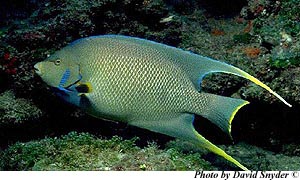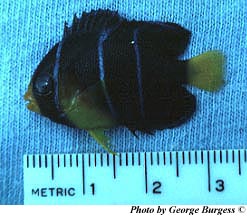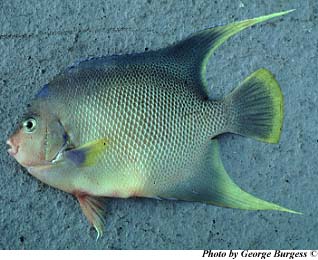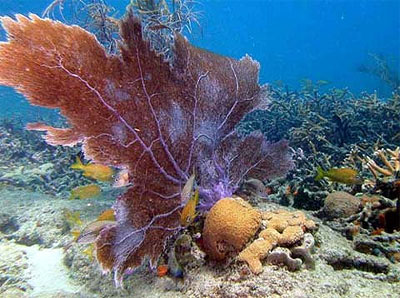
Holacanthus bermudensis
This blue-brown fish has trailing dorsal and anal fins that are blue with yellow-edges. Juveniles are dark blue with yellow highlights and bright blue bars on the body. They are observed forming breeding pairs, and can produce loud thumping sounds to startle predators and attract attention. They live in and around coral reefs where they graze on coral and sponges. Easily confused with queen angelfish, they can also interbreed with them and produce a varying coloration of offspring.
Order – Perciformes
Family – Pomacanthidae
Genus – Holacanthus
Species – bermudensis
Common Names

Blue angelfish (English), angelfish (English), blue angel (English), corn sugar (English), and isabelita azul (Spanish).
Importance to Humans
Although not commercially important, the blue angelfish is collected for home and public aquarium display tanks.
Conservation
This fish is not listed as endangered or vulnerable with the World Conservation Union (IUCN). The IUCN is a global union of states, governmental agencies, and non-governmental organizations in a partnership that assesses the conservation status of species.
> Check the status of the blue angelfish at the IUCN website.
Geographical Distribution

It occurs on the continental shelf of the tropical western Atlantic Ocean. It is found in Bermuda and along the coast of the Americas from North Carolina to the Yucatan peninsula of Mexico, including the Gulf of Mexico.
Habitat
The blue angelfish is a benthic species, staying near the bottom in areas of sponge, coral, or rock at depths ranging from 6-300 feet (2-92 m). It gracefully moves about the reef during the day and sleeps hidden away at night. The juvenile blue prefers to live in bays, channels, and inshore reefs while the juvenile queen prefers offshore reefs.
Biology
Distinctive Features
The body is compressed and discus-shaped, the head is bluntly rounded, and the single dorsal fin is long and continuous. As the adults age, the lobes of the dorsal and anal fins become produced into long filaments.

Coloration
The adult blue angelfish is blue-brownish overall, with green hues and a blue caudal fin (tail) bordered in yellow. It resembles a subdued version of its iridescent relative, the queen angelfish (Holacanthus ciliaris). The queen, however, has a completely yellow tail and a dark, ringed circle with blue spots on its forehead. The blue angelfish only has a dark smudge on its forehead. The queen angelfish is a more insular species, preferring reefs that surround offshore islands.
There are some areas where both species are found together and it is in these areas where they have been known to interbreed. This interbreeding creates hybrids that share the characteristics of both parents. The hybrid can cover a wide spectrum of characteristics, from almost pure blue to almost pure queen.
The juvenile appearance is quite different from that of the adult. Juveniles are dark blue with a yellow tail, a yellow area around the pectoral fins, and brilliant blue vertical bars on the body. The juveniles of the blue and the queen angelfish are so similar in appearance that the only way to distinguish them from one another is to note the curvature of the bars on the body. The bars on the juvenile blue angel tend to be straighter than those of the juvenile queen angel. As juveniles grow, their color gradually changes from the dark blues of youth to the blues, greens, and yellows of the adults.
Size
The adult blue can obtain sizes up to 18 inches (45 cm).
Dentition
They have small, protractile mouths and comb-like teeth arranged in brush-like bands.

Food Habits
The blue angel’s diet consists mostly of sponges but they have been known to occasionally snacking on tunicates, corals, and algae. Young blue angelfish feed on external parasites that they pick from the bodies of other fishes that visit cleaning stations.Reproduction
Adult blue angels are generally found in pairs year round, perhaps suggesting a monogamous relationship between the male and the female. They spawn by slowly rising up in the water column, bringing their bellies close together, and releasing large amounts of eggs and sperm. A female can release anywhere from 25 to 75 thousand eggs each evening and as many as ten million during each spawning cycle. The eggs are transparent, pelagic, and each contains a single drop of oil to provide buoyancy.
The eggs hatch in 15 to 20 hours into a sort of pro-larval stage where the creature is attached to a large yolk sac and lacks functional fins, eyes and gut. It takes about 48 hours for the yolk to be absorbed, during which time the fish develops into true larvae and begins to feed on plankton. Growth is rapid and 3 to 4 weeks after hatching the fish settles on the bottom. The juveniles are strongly territorial, defending areas where they have set up a cleaning station. A cleaning station is a place, usually a coral head or boulder, where a large fish allows a smaller animal to remove parasites from its body. These are unique areas because of the truce that exists between predators and prey in the station. It has been suggested that the bright, contrasting colors of the juveniles may serve to advertise its position to prospective customers.
Taxonomy
Holacanthus bermudensis, the blue angelfish, was originally described by Goode in 1876. It has previously been referred to as Holocanthus isabelita and Holocanthus ciliaris bermudensis, which appear in some of the older publications.
Prepared by: Casey Patton